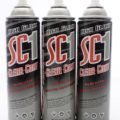
Tip: Homemade Anti Fog for Goggles and Visors
August 6, 2013
Motorcycle Racers are a diverse group of people who come from all walks of life, but the most successful Professional Racers all have one thing in common – none of them are blind. That’s right, vision is a crucial component for being able to ride a motorcycle well. Or at least farther than the first turn. Without being able to see most of us wouldn’t even find our bikes; we’d be left fumbling around in the garage only to end up straddling the lawn mower. Goggles and flip-down face shields may help protect your eyeballs and keep things in focus, but when conditions conspire against you they can fog up and impair your vision worse than multiple shots of Jagermeister.
Fog inside of goggles or face shields is a result of the temperature and humidity inside your goggles or shield being higher than the outside of them. In other words, when you’re sweating like Pamela Anderson in a spelling contest, the hot air in your goggles becomes supersaturated with moisture and is then condensed into fog.
Since air flow is the key to preventing fog and helmets and goggles are ventilated, it’s rarely an issue when riding. But stop to check the map or laugh at your buddy who’s writhing in pain after a spectacular crash, and things can quickly fog up. This is where anti-fog for your lens or shield becomes essential – you want to be able to see your friend lying in the dirt.
Anti-fog spray or a No Fog lens cloth are relatively cheap and work great. However, if you happen to run out of spray or your lens cloth gets converted to emergency toilet paper, a home remedy is as close as your kitchen or bathroom.
Liquid Dish Soap – Some people use a small drop of (mild) dish soap on a soft cloth and apply it to the inside of the lens or face shield, then let it dry and buff just enough of it off to provide clear vision. Some people dilute the soap with water in a spray bottle and spray it on like traditional anti-fog. Some people don’t have dish soap because delivery pizza and Chinese take out is their only form of sustenance.
Toothpaste – This is an old scuba diver’s trick. Make sure you use an old school toothpaste that doesn’t contain bleaching agents, flavor crystals, or rubbing compound. Apply a thin layer on the inside, then gently rinse it off with water and dry it with a soft cloth. I’m a bit skeptical about this – scuba masks tend to have glass lenses and I wonder if toothpaste wouldn’t be too abrasive for a plastic lens. I couldn’t actually test this method because I stopped brushing my teeth in 1987.
Shaving Cream – Applied the same way as soap, using a small amount on a soft cloth and rubbing it over the inside of the lens or face shield, then letting it dry and buffing off any residue. Once the lens is clear, apply copious amounts of Brut cologne to attract women when exploring trailer parks.
Baby Shampoo – I don’t mind stealing candy from a baby, so what’s a little shampoo? Apply with the same technique as dish soap and shaving cream.
Potatoes – Cut a wedge of spud and rub the white part over the lens; let it air dry then buff it clean. I couldn’t test this method either – one of the conditions the State imposed on me to be considered ‘no longer a danger to myself or others’ is that I’m not allowed to handle sharp utensils.
Spit– Since I quit brushing my teeth my saliva tends to be caustic and burn through plastics with a low melting point, so I couldn’t try this. But I remember doing this a lot as a kid; the effect is minimal and brief.
If you decide to try one of these handy home remedies, make sure to start with a clean surface – rubbing anything over a dirty lens or face shield will invariably result in scratches.
Of course there is another trick to prevent goggles from fogging; it’s my preferred method because I’m lazy and don’t want to have to prep anything before I ride. I use a Roko Quik Strap. This allows me to quickly and easily remove my goggles with one hand before they have a chance to fog up and reattach them just as fast.
Next time you have a problem with fogging and find yourself without a purpose-built solution, reach for some soap, baby shampoo, or shaving cream; they really work. Seeing is believing!








